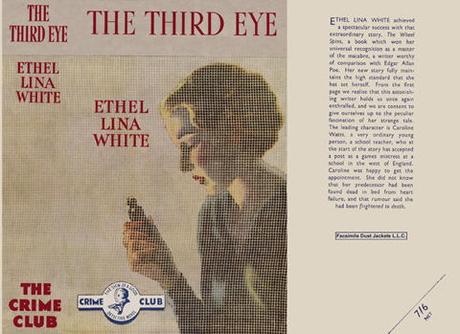
Book Review by George S: The Third Eye is a paranoid novel, a book in which a young woman is caught up in the evil schemes of utterly ruthless enemies, and is put in situations where she does not know what is real and what is imagined. In this respect it is like Ethel Lina White’s best-known novel, The Wheel Spins, which was sharpened up by Alfred Hitchcock and his scriptwriters, to become The Lady Vanishes.
(Warning: Spoilers ahead.) The heroine of The Third Eye is Caroline Watt, a young woman just starting work as games teacher at the Abbey School. This is a place about which odd rumours are beginning to circulate. We soon gather that Mrs Nash, its Head, is under the thumb of the matron – Miss Yaxley-Moore, a vile woman with no redeeming features. We first meet her in her pyjamas:
At one time the woman may have been handsome, but the lines of her figure were lot in bulk, while her face had sagged and deepened to the color of port wine. Her eyes – violet-blue – were bloodshot and set in dark pouches. Her lips were coarse, her nose an heirloom of the Norman period.
An ancient bath-robe of orange towelling was open to display creased purple pajamas. To complete Caroline’s amazement, her hair was set with metal clips and she wore a rubber chin-strap with perfect unconcern.
Miss Yaxley-Moore’s hold over the Head is mostly due to her apparent psychic ability. She holds seances, in which Mrs Nash’s dead husband comes back to tell her how to invest her money. One of these is described rather well in a chapter when Caroline becomes an unwilling participant. The matron also claims to have the ‘third eye’, and to be able to predict the future. She foretold one death before the events of the book began, and another prophecy is soon fulfilled, slightly ambiguously.
As matron she is incompetent. She dismisses the illnesses of girls she does not approve of. It is one of these that really set the story in motion. The doctor prescribes medicine for one student. Miss Yaxley-Moore decides that the girl does not need it. Caroline discovers the medicine bottles unopened, and hides them as evidence against the matron.
During the school holidays Caroline goes skiing in Switzerland, while Miss Yaxley-Moore visits the decaying grand house of her half-sister, Miss Bat of Bat House. Miss Bat is even more twisted and demented than Miss Yaxley-Moore. The two sisters hate and resent each other. Miss Yaxley-Moore knows that if Caroline reveals the secret about the medicine she will be dismissed from the school. Miss Bat knows that if this happened, Miss Yaxley-Moore will be her unwanted house-guest permanently. The two of them therefore plot to delay Caroline’s return to school, to give them a chance to find the incriminating evidence.
The second half of the novel describes Caroline’s long coach journey back to school. It is a day of dense fog, and Caroline is subjected to various catastrophes – some plotted by the evil pair, some just chance.
In the end Caroline survives, of course, even though Miss Bat (more ruthless than her half-sister) actually attempts to murder her. The book ends with Miss Yaxley-Moore returning in disgrace to Bat House. The book’s last, rather splendid, sentence is:
Linked together in an enforced partnership of hatred, the two women sat and faced each other in the fading light.
The book is pure melodrama. The heroine is utterly decent, the villains totally evil. It is a very episodic book, with some episodes working better than others. The séance near the beginning is suitably creepy, but Miss Yaxley-Moore’s apparent psychic abilities fade out of the picture as the hunt for the medicine bottles takes over the story. The bus journey through the fog is effectively done, with Caroline knowing that one of her fellow-passengers is dangerous, but not knowing which one or knowing who to trust. This extended journey hurts the structure of the novel, though, because Miss Yaxley-Moore, the chief villainess and the book’s most interesting character, is absent from the narrative for a long while.
Hopping from incident to incident and theme to theme, the book has an improvised feel. There are big holes in the plot. It is never quite clear how Miss Yaxley-Moore was gaining anything by getting the supposed ghost of Mrs Nash’s husband to give dubious financial advice. We never gather how Miss Yaxley-Moore successfully predicted two deaths. The novel scuttles away to something else before we get a chance to ask too many questions.
It’s a jolly read, and sometimes an exciting one but in the end I felt disappointed, since there are promising themes that are never properly developed, and the psychology of the two evil half-sisters is just too twisted to be credible. It whiled away two train journeys very adequately, though.
